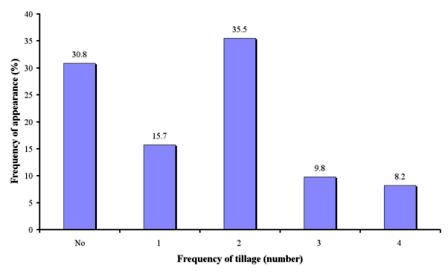Frequency of tillage
As it was mentioned above tillage erosion tillage erosion is considered as the main cause of soil translocation from the upper hilly areas down slope to the lower land. Studies conducted during the execution of the EU research project TERON have shown that several factors affect the annual soil loss due tillage erosion such as type of tillage instrument, plow depth, wheel speed of the tractor, soil moisture content, slope gradient, direction of tillage operation, frequency of tillage operations, etc. One of the practices for reducing tillage erosion is minimum frequency of tillage operations. The frequency of tillage has been defined in this project as the number of tillage operations per year conducted by the farmer. It has been determined by contacting the land owner. The following classes of tillage frequency have been used: no tillage, tillage once per year, tillage twice per year, tillage three times per year, and tillage four times per year.
Data for tillage frequency have been collected in 451 study field sites, corresponding to 10 study sites. The analysis of the data showed that soils are tilled twice a year in 35.5% of the study field sites, corresponding to the study sites of Secano Interior-Chile, Santiago Island-Cape Verde, Mamora Sehoul-Morocco, Zeuss Koutine-Tunisia, Cointzio Catchment-Mexico, and Crete-Greece (Fig 60). Three and four times tillage operations per year have been recorded in about equal number of field sites, covering 9.8% and 8.2% of the cases, respectively. Such cultivation practices have been found in the study sites of Secano Interior-Chile, Mamora Sehoul-Morocco, Guadalentin Basin Murcia-Spain, Cointzio Catchment-Mexico, and Zeuss Koutine-Tunisia. Tillage frequency once per year has been defined in 15.7% of the study field sites, corresponding to the study sites of Secano Interior-Chile, Mamora Sehoul-Morocco, Guadalentin Basin Murcia-Spain, Zeuss Koutine-Tunisia, and Crete-Greece. Finally, no tillage operations have been recorded in 33.7% of the study field sites, corresponding to the study sites of Santiago Island-Cape Verde, Mamora Sehoul-Morocco, Guadalentin Basin Murcia-Spain, Zeuss Koutine-Tunisia, and Crete-Greece.

Fig. 60. Distribution of tillage frequency recorded in the study field sites